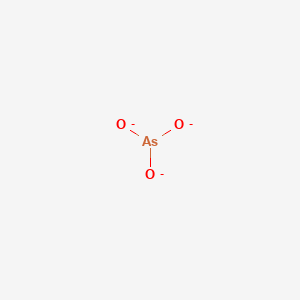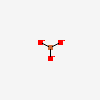Arsenite ion
PubChem CID
544
Molecular Formula
Synonyms
- arsorite
- 15502-74-6
- Arsenite ion
- Trisoxylatoarsine
- arsenite(3-)
Molecular Weight
122.920 g/mol
Computed by PubChem 2.2 (PubChem release 2021.10.14)
Dates
- Create:2004-09-16
- Modify:2025-01-11
Description
Arsenite(3-) is an arsenite ion resulting from the removal of all three protons from the hydroxy groups of arsenous acid. It is an arsenite ion and a trivalent inorganic anion. It is a conjugate base of an arsenite(2-).
See also:  potassium arsenite anhydrous (active moiety of);
potassium arsenite anhydrous (active moiety of);  Cupric arsenite (is active moiety of);
Cupric arsenite (is active moiety of);  Quinine arsenite (is active moiety of).
Quinine arsenite (is active moiety of).
 potassium arsenite anhydrous (active moiety of);
potassium arsenite anhydrous (active moiety of);  Cupric arsenite (is active moiety of);
Cupric arsenite (is active moiety of);  Quinine arsenite (is active moiety of).
Quinine arsenite (is active moiety of).Chemical Structure Depiction

Conformer generation is disallowed since MMFF94s unsupported element
arsorite
Computed by Lexichem TK 2.7.0 (PubChem release 2021.10.14)
InChI=1S/AsO3/c2-1(3)4/q-3
Computed by InChI 1.0.6 (PubChem release 2021.10.14)
OWTFKEBRIAXSMO-UHFFFAOYSA-N
Computed by InChI 1.0.6 (PubChem release 2021.10.14)
[O-][As]([O-])[O-]
Computed by OEChem 2.3.0 (PubChem release 2024.12.12)
AsO3-3
Computed by PubChem 2.2 (PubChem release 2021.10.14)
arsenite
Property Name
Property Value
Reference
Property Name
Molecular Weight
Property Value
122.920 g/mol
Reference
Computed by PubChem 2.2 (PubChem release 2021.10.14)
Property Name
Hydrogen Bond Donor Count
Property Value
0
Reference
Computed by Cactvs 3.4.8.18 (PubChem release 2021.10.14)
Property Name
Hydrogen Bond Acceptor Count
Property Value
3
Reference
Computed by Cactvs 3.4.8.18 (PubChem release 2021.10.14)
Property Name
Rotatable Bond Count
Property Value
0
Reference
Computed by Cactvs 3.4.8.18 (PubChem release 2021.10.14)
Property Name
Exact Mass
Property Value
122.906338 Da
Reference
Computed by PubChem 2.2 (PubChem release 2021.10.14)
Property Name
Monoisotopic Mass
Property Value
122.906338 Da
Reference
Computed by PubChem 2.2 (PubChem release 2021.10.14)
Property Name
Topological Polar Surface Area
Property Value
69.2 Ų
Reference
Computed by Cactvs 3.4.8.18 (PubChem release 2021.10.14)
Property Name
Heavy Atom Count
Property Value
4
Reference
Computed by PubChem
Property Name
Formal Charge
Property Value
-3
Reference
Computed by PubChem
Property Name
Complexity
Property Value
8
Reference
Computed by Cactvs 3.4.8.18 (PubChem release 2021.10.14)
Property Name
Isotope Atom Count
Property Value
0
Reference
Computed by PubChem
Property Name
Defined Atom Stereocenter Count
Property Value
0
Reference
Computed by PubChem
Property Name
Undefined Atom Stereocenter Count
Property Value
0
Reference
Computed by PubChem
Property Name
Defined Bond Stereocenter Count
Property Value
0
Reference
Computed by PubChem
Property Name
Undefined Bond Stereocenter Count
Property Value
0
Reference
Computed by PubChem
Property Name
Covalently-Bonded Unit Count
Property Value
1
Reference
Computed by PubChem
Property Name
Compound Is Canonicalized
Property Value
Yes
Reference
Computed by PubChem (release 2021.10.14)
Potential endocrine disrupting compound
S109 | PARCEDC | List of 7074 potential endocrine disrupting compounds (EDCs) by PARC T4.2 | DOI:10.5281/zenodo.10944198
Follow these links to do a live 2D search or do a live 3D search for this compound, sorted by annotation score. This section is deprecated (see here for details), but these live search links provide equivalent functionality to the table that was previously shown here.
Mixtures, Components, and Neutralized Forms Count
Similar Compounds (2D)
Similar Conformers (3D)
Same Count
potassium arsenite anhydrous (active moiety of)
Cupric arsenite (is active moiety of)
Quinine arsenite (is active moiety of)
Teratogens
An agent that causes the production of physical defects in the developing embryo. (See all compounds classified as Teratogens.)
PDBe Ligand Code
PDBe Conformer
- CAS Common ChemistryLICENSEThe data from CAS Common Chemistry is provided under a CC-BY-NC 4.0 license, unless otherwise stated.https://creativecommons.org/licenses/by-nc/4.0/
- ChemIDplusChemIDplus Chemical Information Classificationhttps://pubchem.ncbi.nlm.nih.gov/source/ChemIDplus
- DrugBankLICENSECreative Common's Attribution-NonCommercial 4.0 International License (http://creativecommons.org/licenses/by-nc/4.0/legalcode)https://www.drugbank.ca/legal/terms_of_useArsenite ionhttps://www.drugbank.ca/drugs/DB18509
- EPA DSSToxCompTox Chemicals Dashboard Chemical Listshttps://comptox.epa.gov/dashboard/chemical-lists/
- FDA Global Substance Registration System (GSRS)LICENSEUnless otherwise noted, the contents of the FDA website (www.fda.gov), both text and graphics, are not copyrighted. They are in the public domain and may be republished, reprinted and otherwise used freely by anyone without the need to obtain permission from FDA. Credit to the U.S. Food and Drug Administration as the source is appreciated but not required.https://www.fda.gov/about-fda/about-website/website-policies#linking
- ChEBI
- Comparative Toxicogenomics Database (CTD)LICENSEIt is to be used only for research and educational purposes. Any reproduction or use for commercial purpose is prohibited without the prior express written permission of NC State University.http://ctdbase.org/about/legal.jsp
- E. coli Metabolome Database (ECMDB)
- FooDBLICENSEFooDB is offered to the public as a freely available resource. Use and re-distribution of the data, in whole or in part, for commercial purposes requires explicit permission of the authors and explicit acknowledgment of the source material (FooDB) and the original publication.https://foodb.ca/about
- Japan Chemical Substance Dictionary (Nikkaji)
- KEGGLICENSEAcademic users may freely use the KEGG website. Non-academic use of KEGG generally requires a commercial licensehttps://www.kegg.jp/kegg/legal.html
- NORMAN Suspect List ExchangeLICENSEData: CC-BY 4.0; Code (hosted by ECI, LCSB): Artistic-2.0https://creativecommons.org/licenses/by/4.0/NORMAN Suspect List Exchange Classificationhttps://www.norman-network.com/nds/SLE/
- Protein Data Bank in Europe (PDBe)
- RCSB Protein Data Bank (RCSB PDB)LICENSEData files contained in the PDB archive (ftp://ftp.wwpdb.org) are free of all copyright restrictions and made fully and freely available for both non-commercial and commercial use. Users of the data should attribute the original authors of that structural data.https://www.rcsb.org/pages/policies
- Wikidataortho-arsenite ionhttps://www.wikidata.org/wiki/Q26841209
- PubChem
- Medical Subject Headings (MeSH)LICENSEWorks produced by the U.S. government are not subject to copyright protection in the United States. Any such works found on National Library of Medicine (NLM) Web sites may be freely used or reproduced without permission in the U.S.https://www.nlm.nih.gov/copyright.html
- EPA Substance Registry ServicesEPA SRS List Classificationhttps://sor.epa.gov/sor_internet/registry/substreg/LandingPage.do
- MolGenieMolGenie Organic Chemistry Ontologyhttps://github.com/MolGenie/ontology/
- NCBI
CONTENTS
